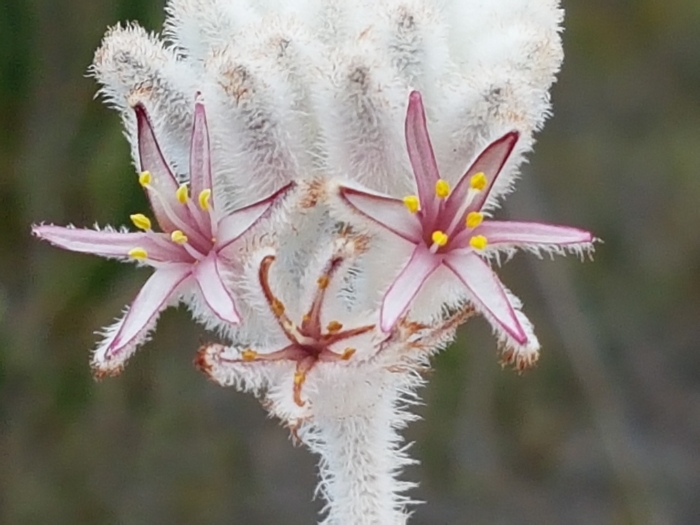Cape Edelweiss
(Lanaria lanata)
Cape Edelweiss (Lanaria lanata)
/
/

Paul venter
CC BY-SA 4.0
Image By:
Paul venter
Recorded By:
Copyright:
CC BY-SA 4.0
Copyright Notice:
Photo by: Paul venter | License Type: CC BY-SA 4.0 | License URL: https://creativecommons.org/licenses/by-sa/4.0 | Uploader: Paul venter | Publisher: Wikimedia Commons | Title: Lanaria_lanata01.jpg | Notes: ''[[Larix laricina]]'' - US NOAA photo |





















































Estimated Native Range
Summary
Lanaria lanata, commonly known as Cape Edelweiss, is an evergreen perennial herb native to the mountainous fynbos and rocky sandstone slopes of South Africa. It typically grows to a height of 1-3 feet (0.3-0.9 meters) and a width of 1-2 feet (0.3-0.6 meters). This plant is characterized by its stiff, ribbed leaves that arise from a woody rootstock. The leaves are evergreen, channelled, and finely serrate along the margins. Cape Edelweiss is notable for its densely woolly, white heads that enclose the true flowers, which are mauve in color and appear in the summer. The flower heads are showy and peculiar to the species, often mistaken for the flowers themselves. Flowering is particularly profuse following fires, which is a common ecological trigger in its native fynbos habitat.
Cape Edelweiss is valued for its unique and striking appearance, with the woolly heads providing a textural contrast in gardens. It is used in rock gardens, as a border plant, and in xeriscaping due to its low water requirements. In cultivation, it thrives in full sun and well-drained soils, tolerating both low and medium amounts of water. While it is relatively easy to maintain, it may require protection from excessive moisture and cold temperatures. There are no widely known cultivars of this species, and it is not typically associated with significant horticultural problems or diseases. However, gardeners should be aware that it may not tolerate overly wet or cold conditions well.CC BY-SA 4.0
Cape Edelweiss is valued for its unique and striking appearance, with the woolly heads providing a textural contrast in gardens. It is used in rock gardens, as a border plant, and in xeriscaping due to its low water requirements. In cultivation, it thrives in full sun and well-drained soils, tolerating both low and medium amounts of water. While it is relatively easy to maintain, it may require protection from excessive moisture and cold temperatures. There are no widely known cultivars of this species, and it is not typically associated with significant horticultural problems or diseases. However, gardeners should be aware that it may not tolerate overly wet or cold conditions well.CC BY-SA 4.0
Plant Description
- Plant Type: Grass
- Height: 1-3 feet
- Width: 1-2 feet
- Growth Rate: Moderate
- Flower Color: Pink
- Flowering Season: Summer
- Leaf Retention: Evergreen
Growth Requirements
- Sun: Full Sun
- Water: Low, Medium
- Drainage: Medium, Fast
Common Uses
Low Maintenance, Potted Plant, Rock Garden
Natural Habitat
Native to mountainous fynbos and rocky sandstone slopes in South Africa
Other Names
Common Names: Lambtails, Kapokblom, Perdekapok
Scientific Names: , Lanaria lanata, Lanaria plumosa, Argolasia capensis, Argolasia lanata, Argolasia plumosa, Dilatris hexandra, Hyacinthus lanatus,
GBIF Accepted Name: Lanaria lanata (L.) T.Durand & Schinz